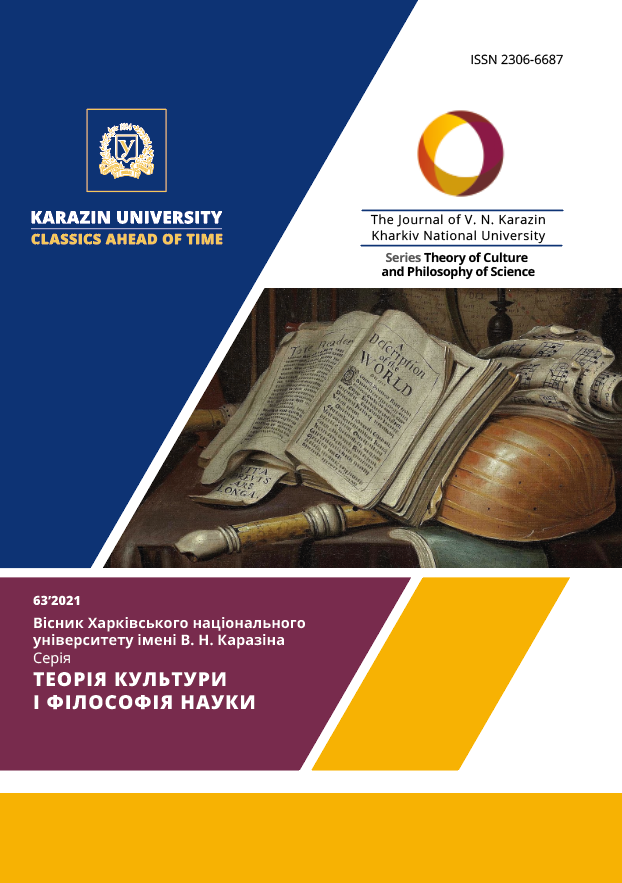THE ROLE OF THE PRINCIPLE OF CURATION IN THE CONTEMPORARY CULTURE
Abstract
The article analyzes phenomenon of the «principle of curation» in historical and philosophical development. In the modern world, overloaded with large volumes of information, it is not just access to information that becomes important, but the ability to navigate it. Problems of critical reflection, choice, interpretation in the information space are gaining in importance. That is exactly why the use of the principle of curation is proposed to implement these processes. The authors consider history of the emergence of the concepts of «curator» and «curatorship», delineation of the features of curatorial principle and differences in meanings and understanding of the principle of curation.
Having considered the history of transformation of these concepts, having analyzed their use in various fields, the authors come to the conclusion that semantic component of the curator changes over time. If initial connotations were limited to the view of the curator as a guardian and caretaker of collections, then in the modern sense curator him/herself is a creative subject. Therefore, the interpretation of works of art essentially depends on the creative activity of the curator and the space that he creates for presentation. Modern practice of curation should be considered as a newly formed field of activity, which is fundamentally different from the forms that preceded it. In the 21st century, the principle of curation is becoming a universal and necessary method of presenting selected and orderly information, which aims to solve the problem. Curators are the ones who work with this flow of information in the era of information overload: they process it, systematize, organize, conceptualize and present it to the public, thus becoming liquidators of the problem of information overload.
The article puts forward a hypothesis for further philosophical reflection: the curatorial principle is a necessary component for organizing the presentation space of a cultural archive.
Downloads
References
Yarto, Bilbao, Edurne, Ana. (2018) Micro-Curating : The Role of SVAOs (Small Visual Arts Organisations) in the History of Exhibition-Making. Notebook for Art, Theory and Related Zones. pp. 118-138. ISSN 1802-8918 [Electronic resource] Retrieved from: https://eprints.whiterose.ac.uk/156506/1/final.pdf
Altshuler, Bruce. (1994). The AvantGarde in Exhibition: New Art in the 20th Century. New York: Abrams.
Calderoni, Irene. (2007) «Creating Shows: Some Notes on Exhibition Aesthetics at the End of the Sixties» in Paul O’Neill, ed., Curating Subjects. London: Open Editions; Amsterdam: De Appel.
Rogoff, Irene. (2006). «Smuggling: A Curatorial Model», in Under Construction: Perspectives on Institutional Practice.Cologne: Walther König.
O’Neill, Paul. (2007). The culture of curating and the curating of culture(s): the development of contemporary curatorial discourse in Europe and North America since 1987. PhD thesis, Middlesex University. [Thesis] Final accepted version (with author’s formatting) . [Electronic resource] Retrieved from: https://eprints.mdx.ac.uk/10763/1/568395.pdf#2
Oprea, Corina. (2017). The end of the curator: on curatorial acts as collective production of knowledge. Loughborough University. Thesis. . [Electronic resource] Retrieved from: https://hdl.handle.net/2134/25605
Bascar, Michael. (2017). The principle of curation. The role of choice in the era of excess / M. Baskar. Moscow: Hell Marhynem Press, 360 pp. (In Russian).
Biryukova, M.V. (2017). Evolution of curatorial projects of the second half of the twentieth century in the context of the theory and philosophy of culture: author's ref. dis. ... Dr. of Cultural Studies / MV Biryukova. Saint-Petersburg, 304 p. (In Russian)
Baudrillard, J. (2001).The System of Things / J. Baudrillard (Translated from the French and an accompanying article by S. Zenkin). - M .: «Rudomino», 219 p. (In Russian).
Baudrillard, J. Simulacra and simulations [Electronic resource] / J. Baudrillard. [Electronic resource] Retrieved from: http://exsistencia.livejournal.com/ (In Russian).
Bruce Ferguson was quoted at his "Main Address" during the Banff 2000 International Curatorial Summit y Banff Center, August 24, 2000: in Melanie Townsend, «The Troubles with Curating», in Townsend, ed., Beyond the Box: Diverging Curatorial Practices (Banff, Canada: Banff Centre Press, 2003)
Herman, E.S. (2016). Curatorial practice in contemporary art. World experience and Ukrainian context: dis. Cand. of Art History: / Herman Elizaveta Serhiivna .Kyiv. 309 p. (In Ukrainian).
Demkina, D.V. (2012). Curation and art project in the system of contemporary art: author's ref. dis. ... cand. art history / DV Demkina. Barnaul, 155 p. (In Russian).
Kostritz, F.A. (2009). Representation of contemporary art in the museum. Theoretical and practical aspects: author's ref. dis. ... cand. art history / FA Kostritz. Saint-Petersburg. 197 p. (In Russian).
Kutenko, O.S. (2021). The phenomenon of curation: presentation of information in the XXI century. Proceedings of the International Scientific Conference of Students and Postgraduates XVII Kharkiv Student Philosophical Readings: to the 100th Anniversary of the Publication of the Logical and Philosophical Treatise L.Y. AND. Wittgenstein. (In Ukrainian).
O’Doggerty, Brian (2015). Inside the white cube. The ideology of gallery space - Moscow: Hell Margin Press. 144 p. : ill.
O’Neill, Paul. (2015). Curation culture and culture curation (s). Москва: Ад Маргинем Пресс. 272 с. (In Russian).
Obrist, Hans Ulrich. (2016). Ways of curation. - Moscow: Hell Marhynem Press. (Garage pro). 160 p. (In Russian).
Prilashkevich, E.E. (2009). Curatorship in modern artistic practice: author. dis. ... Cand. art history / E.E. Prilashkevich. St. Petersburg. 240 p. (In Russian).
Rudy Fuchs cit. from 1983 interview: Debora J. Meijers, «The Museum and the Ahistorical Exhibition» in Greenberg, Ferguson, and Naire, Thinking about Exhibition
Tahlina, Y.S., Kutenko, O.S. (2020). Transfiguration of art representation: search for new formats in the world of isolation / Journal of VN Kharkiv National University Karazina Series "Theory of Culture and Philosophy of Science" Issue 61. DOAJ: https://doaj.org/toc/2306-6687?source (In Ukrainian).




